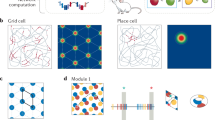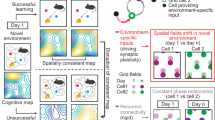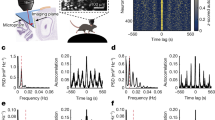Abstract
To determine how hippocampal backprojections influence spatially periodic firing in grid cells, we recorded neural activity in the medial entorhinal cortex (MEC) of rats after temporary inactivation of the hippocampus. We report two major changes in entorhinal grid cells. First, hippocampal inactivation gradually and selectively extinguished the grid pattern. Second, the same grid cells that lost their grid fields acquired substantial tuning to the direction of the rat's head. This transition in firing properties was contingent on a drop in the average firing rate of the grid cells and could be replicated by the removal of an external excitatory drive in an attractor network model in which grid structure emerges by velocity-dependent translation of activity across a network with inhibitory connections. These results point to excitatory drive from the hippocampus, and possibly other regions, as one prerequisite for the formation and translocation of grid patterns in the MEC.
This is a preview of subscription content, access via your institution
Access options
Subscribe to this journal
Receive 12 print issues and online access
$209.00 per year
only $17.42 per issue
Buy this article
- Purchase on Springer Link
- Instant access to full article PDF
Prices may be subject to local taxes which are calculated during checkout








Similar content being viewed by others
References
O'Keefe, J. & Dostrovsky, J. The hippocampus as a spatial map. Preliminary evidence from unit activity in the freely-moving rat. Brain Res. 34, 171–175 (1971).
Fyhn, M., Molden, S., Witter, M.P., Moser, E.I. & Moser, M.B. Spatial representation in the entorhinal cortex. Science 305, 1258–1264 (2004).
Hafting, T., Fyhn, M., Molden, S., Moser, M.B. & Moser, E.I. Microstructure of a spatial map in the entorhinal cortex. Nature 436, 801–806 (2005).
Moser, E.I., Kropff, E. & Moser, M.-B. Place cells, grid cells, and the brain's spatial representation system. Annu. Rev. Neurosci. 31, 69–89 (2008).
Giocomo, L.M., Moser, M.-B. & Moser, E.I. Computational models of grid cells. Neuron 71, 589–603 (2011).
McNaughton, B.L., Battaglia, F.P., Jensen, O., Moser, E.I. & Moser, M.-B. Path integration and the neural basis of the “cognitive map.”. Nat. Rev. Neurosci. 7, 663–678 (2006).
Taube, J.S., Muller, R.U. & Ranck, J.B. Jr. Head-direction cells recorded from the postsubiculum in freely moving rats. I. Description and quantitative analysis. J. Neurosci. 10, 420–435 (1990).
Sargolini, F. et al. Conjunctive representation of position, direction, and velocity in entorhinal cortex. Science 312, 758–762 (2006).
Savelli, F., Yoganarasimha, D. & Knierim, J.J. Influence of boundary removal on the spatial representations of the medial entorhinal cortex. Hippocampus 18, 1270–1282 (2008).
Solstad, T., Boccara, C.N., Kropff, E., Moser, M.B. & Moser, E.I. Representation of geometric borders in the entorhinal cortex. Science 322, 1865–1868 (2008).
Fyhn, M., Hafting, T., Treves, A., Moser, M.-B. & Moser, E.I. Hippocampal remapping and grid realignment in entorhinal cortex. Nature 446, 190–194 (2007).
Fuhs, M.C. & Touretzky, D.S. A spin glass model of path integration in rat medial entorhinal cortex. J. Neurosci. 26, 4266–4276 (2006).
Solstad, T., Moser, E.I. & Einevoll, G.T. From grid cells to place cells: a mathematical model. Hippocampus 16, 1026–1031 (2006).
Molter, C. & Yamaguchi, Y. Entorhinal theta phase precession sculpts dentate gyrus place fields. Hippocampus 18, 919–930 (2008).
Rolls, E.T., Stringer, S.M. & Elliot, T. Entorhinal cortex grid cells can map to hippocampal place cells by competitive learning. Network 17, 447–465 (2006).
de Almeida, L., Idiart, M. & Lisman, J.E. The input-output transformation of the hippocampal granule cells: from grid cells to place fields. J. Neurosci. 29, 7504–7512 (2009).
Savelli, F. & Knierim, J.J. Hebbian analysis of the transformation of medial entorhinal grid-cell inputs to hippocampal place fields. J. Neurophysiol. 103, 3167–3183 (2010).
Si, B. & Treves, A. The role of competitive learning in the generation of DG fields from EC inputs. Cogn. Neurodyn. 3, 177–187 (2009).
Monaco, J.D. & Abbott, L.F. Modular realignment of entorhinal grid cell activity as a basis for hippocampal remapping. J. Neurosci. 31, 9414–9425 (2011); erratum 31, 11096 (2011).
O'Keefe, J. & Burgess, N. Dual phase and rate coding in hippocampal place cells: theoretical significance and relationship to entorhinal grid cells. Hippocampus 15, 853–866 (2005).
Burgess, N., Barry, C. & O'Keefe, J. An oscillatory interference model of grid cell firing. Hippocampus 17, 801–812 (2007).
Kropff, E. & Treves, A. The emergence of grid cells: intelligent design or just adaptation? Hippocampus 18, 1256–1269 (2008).
Sreenivasan, S. & Fiete, I. Grid cells generate an analog error-correcting code for singularly precise neural computation. Nat. Neurosci. 14, 1330–1337 (2011).
Samu, D., Erös, P., Ujfalussy, B. & Kiss, T. Robust path integration in the entorhinal grid cell system with hippocampal feed-back. Biol. Cybern. 101, 19–34 (2009).
Hafting, T., Fyhn, M., Bonnevie, T., Moser, M.-B. & Moser, E.I. Hippocampus-independent phase precession in entorhinal grid cells. Nature 453, 1248–1252 (2008).
Allen, T.A. et al. Imaging the spread of reversible brain inactivations using fluorescent muscimol. J. Neurosci. Methods 171, 30–38 (2008).
Boccara, C.N. et al. Grid cells in pre- and parasubiculum. Nat. Neurosci. 13, 987–994 (2010).
Langston, R.F. et al. Development of the spatial representation system in the rat. Science 328, 1576–1580 (2010).
O'Keefe, J. & Recce, M.L. Phase relationship between hippocampal place units and the EEG theta rhythm. Hippocampus 3, 317–330 (1993).
Burak, Y. & Fiete, I.R. Accurate path integration in continuous attractor network models of grid cells. PLOS Comput. Biol. 5, e1000291 (2009).
Couey, J.J. et al. Recurrent inhibitory circuitry as a mechanism for grid formation. Nat. Neurosci. doi:10.1038/nn.3310 (20 January 2013).
van Haeften, T., Baks-te-Bulte, L., Goede, P.H., Wouterlood, F.G. & Witter, M.P. Morphological and numerical analysis of synaptic interactions between neurons in deep and superficial layers of the entorhinal cortex of the rat. Hippocampus 13, 943–952 (2003).
Kloosterman, F., Van Haeften, T., Witter, M.P. & Lopes Da Silva, F.H. Electrophysiological characterization of interlaminar entorhinal connections: an essential link for re-entrance in the hippocampal-entorhinal system. Eur. J. Neurosci. 18, 3037–3052 (2003).
Brandon, M.P. et al. Reduction of theta rhythm dissociates grid cell spatial periodicity from directional tuning. Science 332, 595–599 (2011).
Koenig, J., Linder, A.N., Leutgeb, J.K. & Leutgeb, S. The spatial periodicity of grid cells is not sustained during reduced theta oscillations. Science 332, 592–595 (2011).
Alonso, A. & Klink, R. Differential electroresponsiveness of stellate and pyramidal-like cells of medial entorhinal cortex layer II. J. Neurophysiol. 70, 128–143 (1993).
Yoshida, M., Giocomo, L.G. & Hasselmo, M.E. Frequency of subthreshold oscillations at different membrane potential voltages in neurons at different anatomical positions on the dorsoventral axis in the rat medial entorhinal cortex. J. Neurosci. 31, 12683–12694 (2011).
Zilli, E.A. & Hasselmo, M.E. Coupled noisy spiking neurons as velocity-controlled oscillators in a model of grid cell spatial firing. J. Neurosci. 30, 13850–13860 (2010).
Stensola, H. et al. The entorhinal grid map is discretized. Nature 492, 72–78 (2012).
Yartsev, M.M., Witter, M.P. & Ulanovsky, N. Grid cells without theta oscillations in the entorhinal cortex of bats. Nature 479, 103–107 (2011).
Wills, T.J., Cacucci, F., Burgess, N. & O'Keefe, J. Development of the hippocampal cognitive map in preweanling rats. Science 328, 1573–1576 (2010).
Burwell, R.D. & Hafeman, D.M. Positional firing properties of postrhinal cortex neurons. Neuroscience 119, 577–588 (2003).
Muller, R.U. & Kubie, J.L. The firing of hippocampal place cells predicts the future position of freely moving rat. J. Neurosci. 9, 4101–4110 (1989).
Acknowledgements
We thank R. Skjerpeng for programming, M.P. Witter and C.B. Boccara for advice on tetrode locations, M. Mehta and M.P. Witter for discussion, N. Burgess for sharing code for dynamic autocorrelation analyses and A.M. Amundsgård, K. Haugen, K. Jenssen, E. Kråkvik and H. Waade for technical assistance. This work was supported by the Kavli Foundation, a studentship to T.B. from the Faculty of Medicine at NTNU, a Centre of Excellence grant from the Research Council of Norway and an Advanced Investigator Grant to E.I.M. from the European Research Council ('CIRCUIT', grant agreement 232608).
Author information
Authors and Affiliations
Contributions
T.B. and M.F. performed the majority of the experiments; T.B. did the majority of the analyses; B.D. and Y.R. did the network simulations; E.I.M. and T.B. wrote the manuscript, except for the computational model (B.D. and Y.R.); and M.-B.M. supervised the project. All authors contributed to discussion and interpretation.
Corresponding authors
Ethics declarations
Competing interests
The authors declare no competing financial interests.
Supplementary information
Supplementary Text and Figures
Supplementary Figures 1–8 (PDF 9025 kb)
Supplementary Video 1
External input is large enough (100% hippocampal activity). This corresponds to an external input to the right of the transition in Fig. 8b. In this case, the activity on the neuronal sheet is a hexagonal grid. When the animal moves, this activity is translated on the network and follows the movement of the animal without being distorted. The resulting activity at the single cell levels is a hexagonal grid and thus high grid score. (MOV 22999 kb)
Supplementary Video 2
External input is below the transition. In this case, most of the time the activity on the neuronal sheet is still grid like, but the grid changes size, amplitude and orientation as it tries to follow the animals movement sometime turning into stripe patterns (see e.g. t = 0:16). The peak activity also substantially changes between different time steps. Consequently, no grid firing will be observed at the single cell level and substantially low grid scores are found. (MOV 23092 kb)
Rights and permissions
About this article
Cite this article
Bonnevie, T., Dunn, B., Fyhn, M. et al. Grid cells require excitatory drive from the hippocampus. Nat Neurosci 16, 309–317 (2013). https://doi.org/10.1038/nn.3311
Received:
Accepted:
Published:
Issue Date:
DOI: https://doi.org/10.1038/nn.3311
This article is cited by
-
A spatial transformation-based CAN model for information integration within grid cell modules
Cognitive Neurodynamics (2024)
-
Ketamine evoked disruption of entorhinal and hippocampal spatial maps
Nature Communications (2023)
-
Modeling the grid cell activity based on cognitive space transformation
Cognitive Neurodynamics (2023)
-
Disruption of the grid cell network in a mouse model of early Alzheimer’s disease
Nature Communications (2022)
-
Grid cell remapping under three-dimensional object and social landmarks detected by implantable microelectrode arrays for the medial entorhinal cortex
Microsystems & Nanoengineering (2022)



